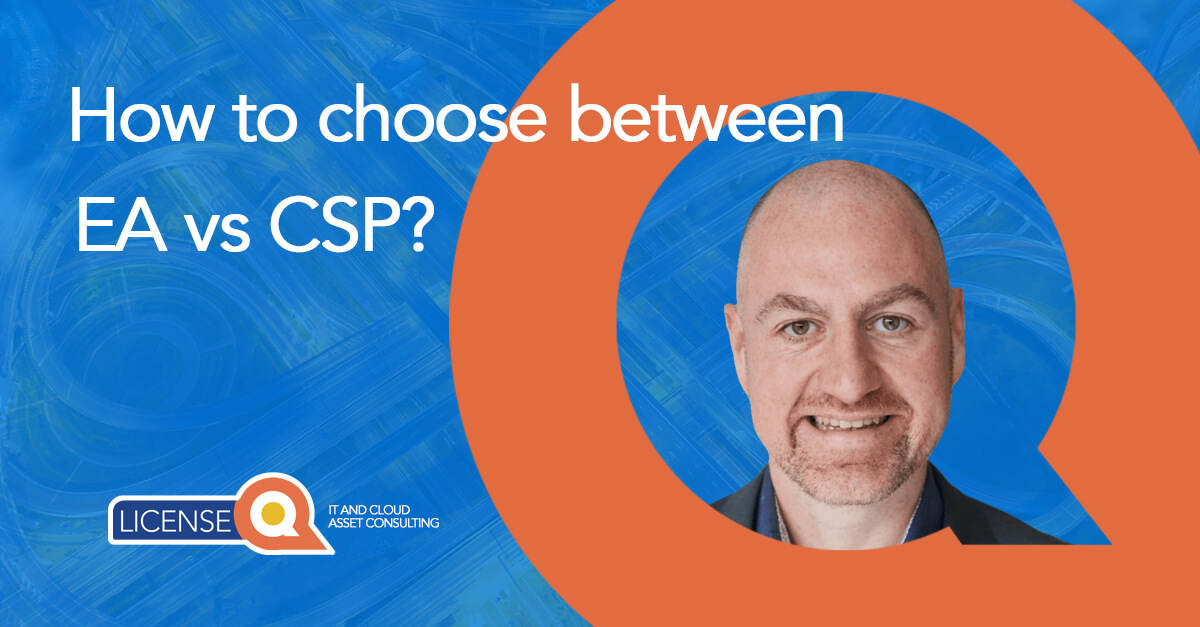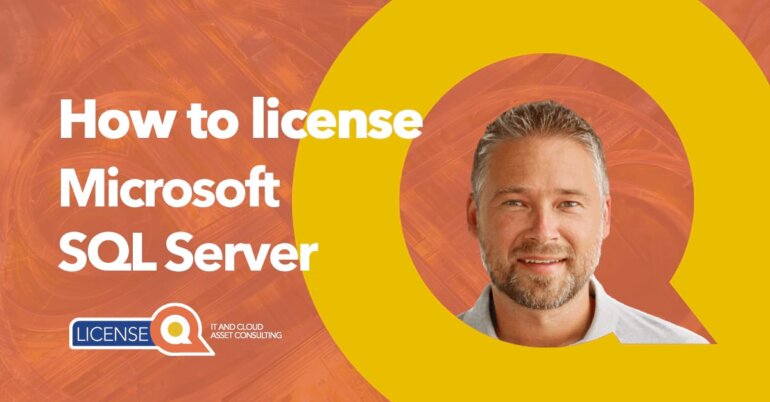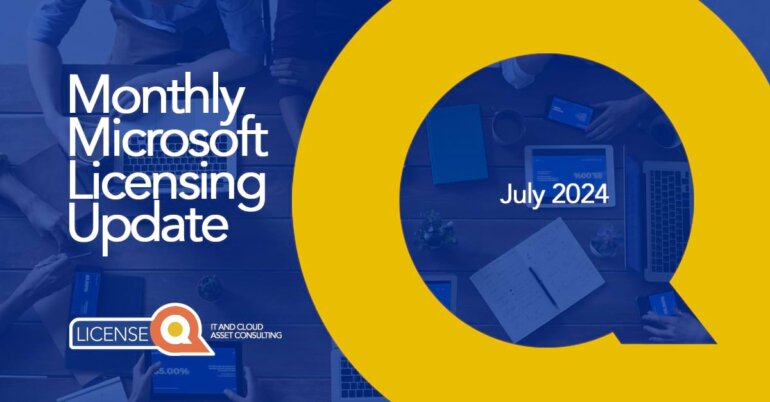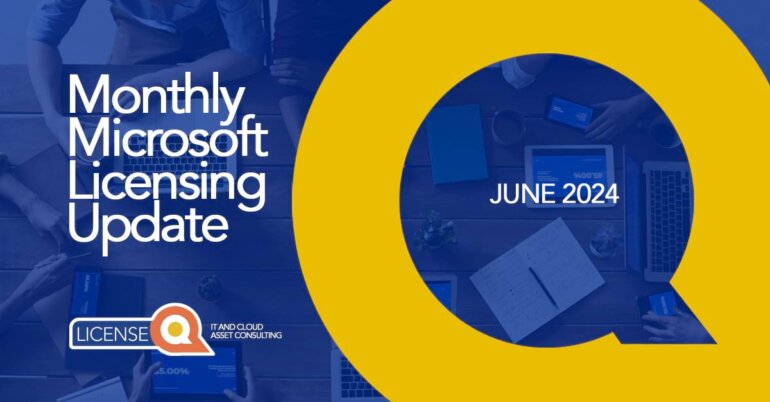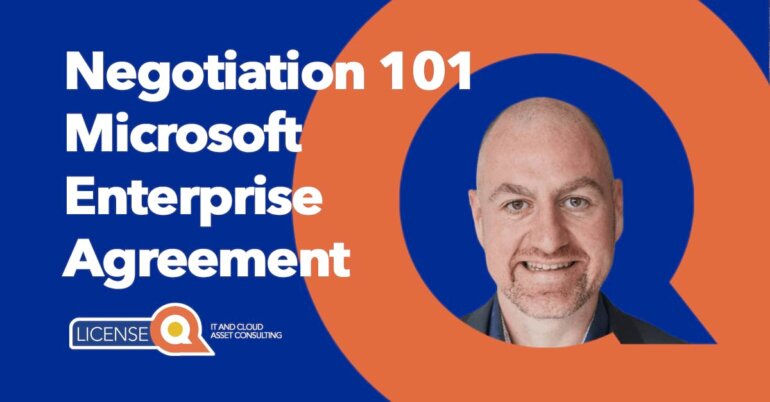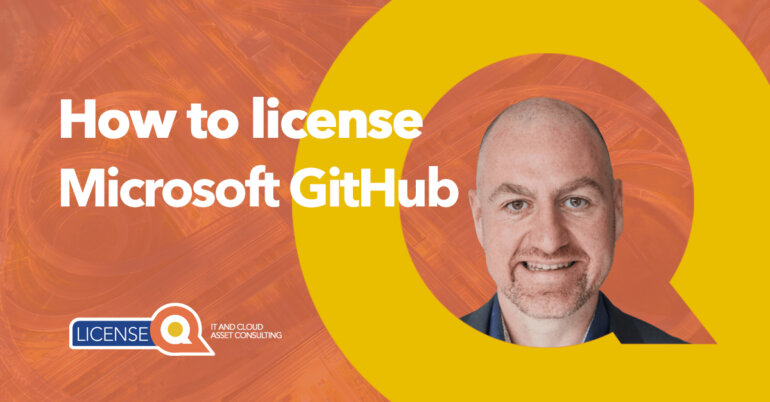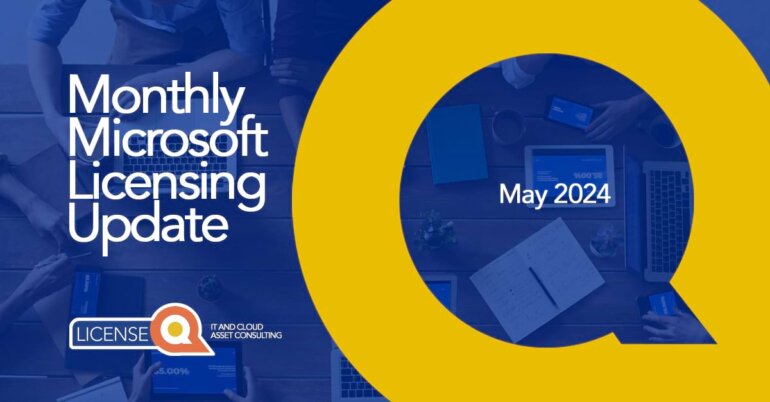EA vs CSP - How do you decide which one is right for you?
To choose between the EA vs CSP you need to understand each contract model, you need to know the main differences and benefits of each type and you need to know what to consider when making a choice between the two.
In today’s digital landscape, every organization is looking for effective licensing solutions for their software and cloud services. Microsoft has many different types and models of licensing contracts. The Enterprise Agreement (EA) and the Cloud Solution Provider (CSP) are two of the most popular options.
In this article, we will explore the main differences between the EA vs CSP programs, the benefits of each, and what to consider when choosing between them. By understanding the unique features of each program, organizations can make an informed decision and choose the licensing solution that best suits their needs.
1. What are the Enterprise Agreement (EA) and the Cloud Solution Provider (CSP)?
Enterprise Agreement
The Enterprise Agreement (EA) is Microsoft’s main licensing vehicle. Within the EA customers can license any of Microsoft’s products and services.
The Enterprise Agreement is a Microsoft licensing program designed for organizations with 500 or more users or devices. It provides volume licensing discounts for Microsoft products and services. The EA also offers flexible licensing options to allow organizations to customize their licensing solutions based on their specific needs.
We have published an entire blog series on the Enterprise Agreement, which you can read on our website.
Cloud Solution Provider
The Cloud Solution Provider (CSP) model is a licensing program that allows Microsoft partners to sell and manage Microsoft cloud services such as Azure, Microsoft 365, and Dynamics 365. Partners sell to their own customers as well as enable customers to purchase software subscription licenses on behalf of Microsoft.
The original CSP model is now called Legacy and continues as the New Commerce Experience model. The main difference between the old CSP and NCE is in how you can buy subscriptions. If you want to know more about this, read our article here [to be written].
You can read more about Microsoft’s main licensing contracts in our article Understand the 6 main Microsoft licensing contracts.

2. What are the main differences between the EA vs CSP?
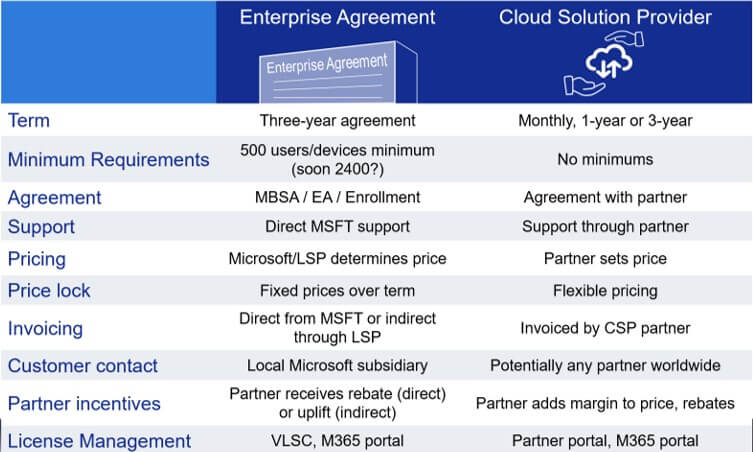
3. Benefits of the Enterprise Agreement
- Predictable costs – Predictability and stability by locking in prices for up to three years. Prices in the EA are locked in for the full contract term, whereas in CSP prices are locked for a maximum of one year.
- Volume discounts – Microsoft offers lower prices for companies that exceed certain thresholds in users and/or devices. This can be especially interesting to large organisations (>2400 users or devices). On top of this, Microsoft is often able to offer relational discounts in the EA, quickly making pricing in the EA more attractive. In CSP, the price is set by your partner and they usually add a margin on top of their purchase price.
- Pricing mechanisms such as Step-ups, Add-ons, From SA & other licensing models (CSP does not know these)
- Customized solutions – Customize licensing solutions to meet specific needs. Choose the products and services that make the most sense for an organization and lock in prices for a longer term.
- Software Assurance (SA) benefits – SA additional benefits include training, support and the ability to upgrade to the latest software versions at no additional cost. CSP does not offer SA, but it will sometimes allow certain SA Benefits for software subscriptions.
- Centralized management – Streamlined and easy management of organization-wide (multiple locations & departments) licensing with one single agreement.
- Priority support – Access to Microsoft’s technical support services to help resolve any issues or concerns with their Microsoft products and services quickly and efficiently.
4. Benefits of the Cloud Solution Provider
- Flexible pricing – Flexible pricing and billing models offered by partners. Including monthly or annual billing, pay-as-you-go, and fixed-term contracts. More cost-effective for organizations with fluctuating or unpredictable usage of Microsoft cloud services.
- Tailored offer – Offers tailored to meet the specific needs of customers, including bundling multiple services together and offering value-added services such as migration, customization and support on top of the licensing cost.
- Greater control and visibility – Partners have greater control and visibility over their customers’ cloud services, including management & monitoring of usage, setting up alerts and notifications, and changing services as needed.
- Simplified management- Simplified management experience for partners and customers, with a single point of contact for all Microsoft cloud services and streamlined billing and invoicing processes.
- Support – Microsoft support services are delivered by the selected partner, including technical support, training and resources. Your partner might charge you additional costs for their support.

5. What to consider when choosing between the EA vs CSP
When choosing between the EA and the CSP you need to consider many factors such as your licensing and support needs, pricing and what type of organization you are. Most importantly: you might need to get creative!
Assess licensing needs
For instance, if you want to move to the cloud, you need to assess how you will migrate, what you will migrate and how fast. This assessment impacts which Microsoft contract you choose. Other considerations: usage patterns, billing/pricing models.
Support
Besides pricing, the main question is “Where do you want your support to come from?”. With an EA support is provided by Microsoft itself, whereas a Microsoft partners provides support in a CSP.
We have seen many partner organizations provide excellent support, sometimes even better than the Microsoft subsidiary itself. As online services (e.g., Office 365) are becoming more mainstream, partners have also made big steps in increasing their knowledge and deployment. Partner organizations can also take advantage of being more flexible and customer driven than Microsoft itself.
Discounts and prices
Loyal EA Microsoft customers will benefit with From SA discount, which can lead to a 15% programmatic discount. Profiling users within the EA can also generate big discounts (not in CSP).
Never choose a ‘one size fits all’ option in the EA, explore your organization’s specific usage and needs to negotiate your contract based on these. Ultimately, buying an entire suite will not work out as the best option.
For either the EA or the CSP our advice is: lock the prices in! Securing a price lock will exempt you from any price increases that Microsoft continues to throw at its customers. There have been more and more price increases recently.
Best practice is to investigate what part of your company is stable and to license these parts against a longer-term price. Your flexible layer can then be licensed in CSP at a monthly rate so you can lower the number of licenses in case of reductions in users/devices.
Stick with what you know
If you are already familiar with one of the contract models, it can make sense to stick with it. As the management of the EA vs the CSP is very different.
Unless the cost benefits of switching are significant, stick to what you know. However, we do always advise to investigate alternative scenario’s, to find out if there are savings to be had.
Level A & B companies
As a company classified as Level A or B (meaning up to 6000 users/devices) in the EA, it is always interesting to request CSP quotes from Microsoft partners.
Especially Level A customers can sometimes find cloud subscriptions at a lower rate in CSP then in their current EA. Unless they are already getting large relational discounts in the EA.
Get creative
Regardless of which of the two contract models you choose, it always pays to get creative. Microsoft is becoming more and more hard line, so securing a good deal requires customers to explore their options, look at combining licensing promos or to buy second hand licenses.
Enterprise Agreement vs Cloud Solution Provider
Our final piece of advice: keep your options open when starting your negotiations and leverage everything you can. Such as a CSP scenario (even if you plan on going with EA). Especially as, strangely, Microsoft does not fully know how much revenue the CSP generates. You can use this uncertainty to your benefit in your negotiations
The best fit for you might actually be a combination of the two models. This is also always an option! This will probably benefit a smaller-sized company more than a larger one.
In this article we discussed two of Microsoft’s main licensing vehicles and hopefully provided some useful insights and tips. Choosing which contract model is right for your organization is only one of many steps in the negotiation and/or renewal process. Need help analysing your needs and making a decision? For more information on how we can help, visit our Contract Negotiation Support page or contact our licensing experts at info@licenseq.com.

